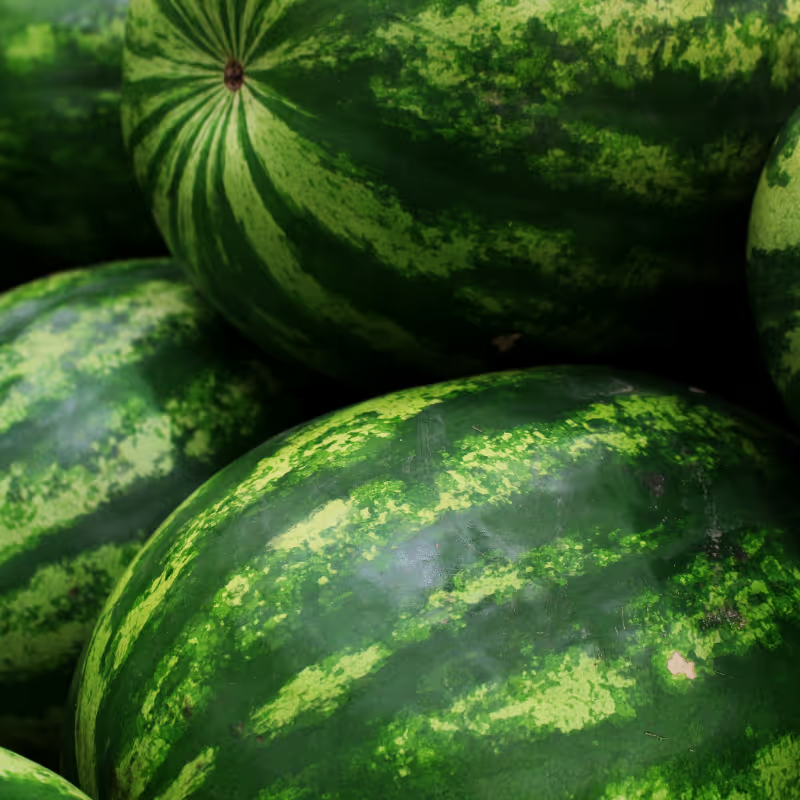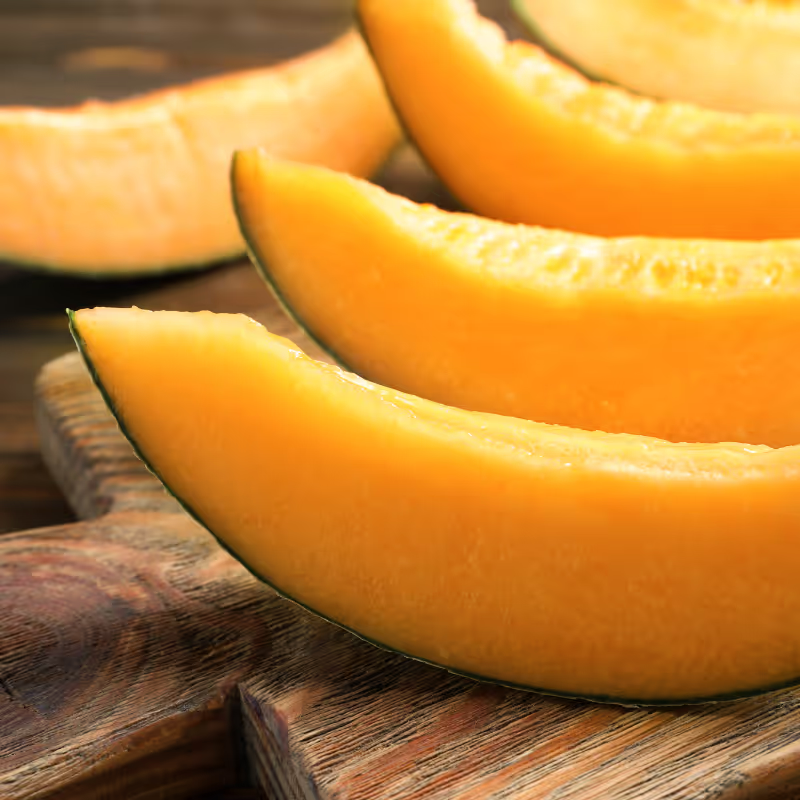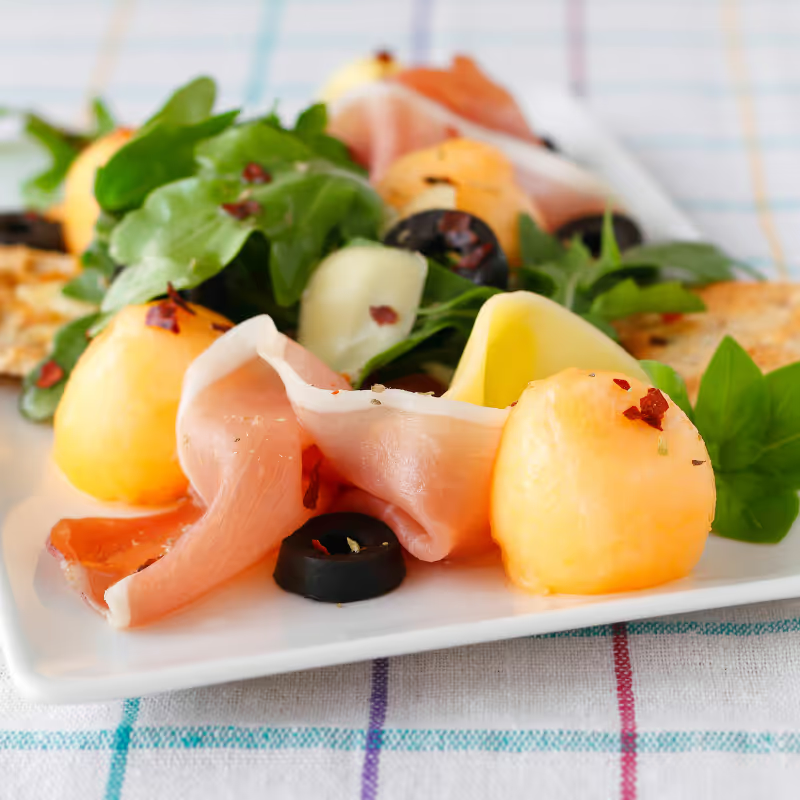What Does it Taste Like?
Melons have a sweet and juicy taste that varies depending on the variety and ripeness. Watermelons are the most watery and refreshing, with a crisp and crunchy texture. Cantaloupes have a more musky and fragrant flavor, with a soft and creamy texture. Honeydews have a mild and mellow taste, with a smooth and velvety texture. Muskmelons have a spicy and aromatic flavor, with a firm and granular texture.
Varieties we grow

Mini Love Watermelon
Small but intensely sweet, this personal-sized watermelon boasts deep red flesh and a crisp texture. Its compact size makes it perfect for snacking, fruit salads, or blending into refreshing drinks.

Divergent
Divergent is a hybrid variety of melon that has a unique flavor and appearance. It is a cross between a cantaloupe and a Galia, with orange flesh and light netting on the skin. It is sweet (Brix 15-18), juicy, and ripens early in its class.
Why Should I Eat It?
Melons are not only delicious, but also nutritious. They are low in calories, fat, and cholesterol, but high in water, fiber, and vitamins. They can help you stay hydrated, regulate your digestion, and boost your immune system. They are especially rich in vitamin A, vitamin C, potassium, and antioxidants, which can protect your eyes, skin, and cells from damage.
Melons

August - September
Melons are a type of fruit that belong to the cucurbit family, which also includes cucumbers, squash, and pumpkins. They come in different shapes, sizes, colors, and flavors, but they all have a thick rind, a fleshy pulp, and many seeds. Some of the most popular varieties of melons are watermelon, cantaloupe, honeydew, and muskmelon.
Recommended Storage
How Do I Store It?
Short Term
Melons can be stored in different ways depending on whether they are whole or cut. Here are some tips for storing melon short term:
- Whole melons: Whole melons can be stored at room temperature for up to a week, or in the refrigerator for up to two weeks. Keep them away from direct sunlight, heat, and moisture, and avoid placing them near other fruits that emit ethylene gas, such as apples, bananas, and tomatoes, which can speed up their ripening and spoilage.
- Cut melons: Cut melons should be stored in an airtight container in the refrigerator for up to three days, or in the freezer for up to six months. To prevent them from drying out, browning, or losing their flavor, cover them with plastic wrap, foil, or a lid, and sprinkle some lemon juice over them.
Long Term
- Freezing: Melons can be frozen as cubes, balls, or puree, and used for smoothies, sorbets, or cocktails. To freeze melon, cut it into your desired shape, spread it on a baking sheet, and freeze it for a few hours, until solid. Then, transfer it to a freezer bag and store it for up to a year.
- Pickling: Melons can be pickled as slices, chunks, or rinds, and used for salads, sandwiches, or cheese boards. To pickle melon, cut it into your desired shape, add it to a jar with some vinegar, sugar, salt, and spices, and refrigerate it for at least a day, until pickled. You can also process the jars in a water bath canner for longer storage.
- Canning: Melons can be canned as jam, jelly, or preserves, and used for toast, pancakes, or yogurt. To can melon, cut it into your desired shape, cook it with some sugar, pectin, and lemon juice, and ladle it into sterilized jars. Then, process the jars in a water bath canner for 10 minutes, or according to the recipe instructions.
- Dehydrating: Melons can be dehydrated as chips, leather, or powder, and used for snacks, granola, or tea. To dehydrate melon, cut it into thin slices, spread it on a baking sheet, and bake it in a low oven for several hours, until dry and crisp. Alternatively, you can use a food dehydrator for faster results.
How Do I Cook It?
Melons are delicious when eaten raw, but they can also be cooked in different ways to create new and exciting dishes. Here are some of the best methods for cooking melon:
- Grilling: Grilling melon gives it a smoky and caramelized flavor that is perfect for summer. Cut the melon into slices or wedges, brush them with some oil or butter, and grill them over high heat for a few minutes on each side, until char marks appear. Season them with some salt, pepper, and herbs, or drizzle them with some honey or balsamic vinegar.
- Pickling: Pickling melon transforms it into a tangy and crunchy treat that can last for months. Cut the melon into thin slices or small pieces, pack them into a jar with some vinegar, sugar, salt, and spices, and refrigerate them for at least 24 hours, until they are fully pickled. Enjoy them as a snack, a salad ingredient, or a cheese board accompaniment.
- Smoothies: Smoothies are a great way to enjoy melon as a refreshing and nutritious drink. Cut the melon into chunks, add them to a blender with some yogurt, milk, ice, and sweetener of your choice, and blend until smooth and frothy. You can also add some other fruits, vegetables, nuts, seeds, or protein powder to make your smoothie more filling and flavorful.
- Salads: Salads are a simple and healthy way to enjoy melon as a light and colorful meal. Cut the melon into cubes, balls, or ribbons, and toss them with some greens, cheese, nuts, or other fruits. Dress them with some olive oil, lemon juice, salt, and pepper, or some yogurt, honey, and mint. You can also add some cooked chicken, shrimp, or ham to make your salad more hearty and protein-rich.

Recommended Recipes
What Goes Well With It?
Melons have a versatile flavor that can pair well with many other ingredients. Here are some of the best flavor pairings for melon:
- Cheese: Melons and cheese are a classic combination that balance each other’s sweetness and saltiness. Try pairing watermelon with feta, cantaloupe with mozzarella, honeydew with ricotta, or muskmelon with brie.
- Mint: Melons and mint are a refreshing combination that enhance each other’s freshness and aroma. Try adding some chopped mint leaves to your melon salad, smoothie, or sorbet.
- Lime: Melons and lime are a tangy combination that contrast each other’s sweetness and acidity. Try squeezing some lime juice over your melon slices, wedges, or balls, or adding some lime zest to your melon dressing, sauce, or jam.
- Prosciutto: Melons and prosciutto are a savory combination that complement each other’s sweetness and saltiness. Try wrapping some thin slices of prosciutto around your melon chunks, skewers, or balls, or serving them together on a platter.
- Ginger: Melons and ginger are a spicy combination that accentuate each other’s sweetness and heat. Try adding some grated ginger to your melon soup, juice, or chutney, or sprinkling some ground ginger over your melon pie, cake, or muffins.
